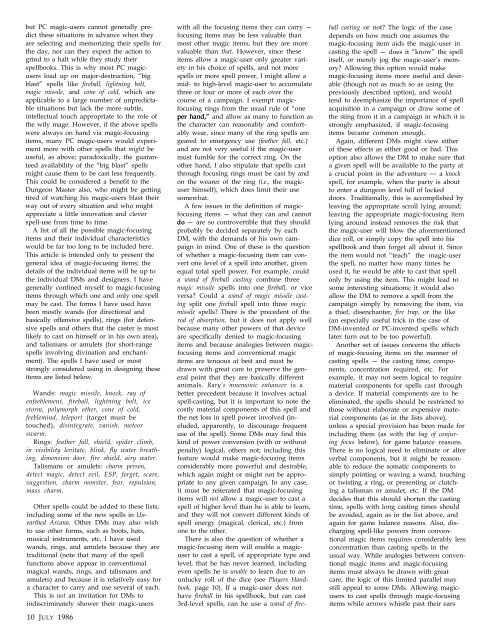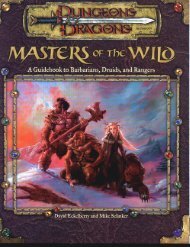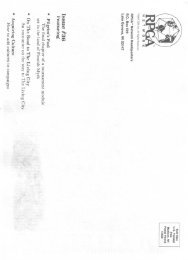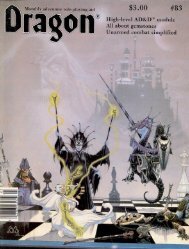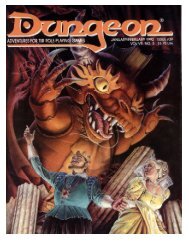Accessory - Dragon Magazine #111.pdf - Index of
Accessory - Dragon Magazine #111.pdf - Index of
Accessory - Dragon Magazine #111.pdf - Index of
You also want an ePaper? Increase the reach of your titles
YUMPU automatically turns print PDFs into web optimized ePapers that Google loves.
ut PC magic-users cannot generally predict<br />
these situations in advance when they<br />
are selecting and memorizing their spells for<br />
the day, nor can they expect the action to<br />
grind to a halt while they study their<br />
spellbooks. This is why most PC magicusers<br />
load up on major-destruction, “big<br />
blast” spells like fireball, lightning bolt,<br />
magic missile, and cone <strong>of</strong> cold, which are<br />
applicable to a large number <strong>of</strong> unpredictable<br />
situations but lack the more subtle,<br />
intellectual touch appropriate to the role <strong>of</strong><br />
the wily mage. However, if the above spells<br />
were always on hand via magic-focusing<br />
items, many PC magic-users would experiment<br />
more with other spells that might be<br />
useful, as above; paradoxically, the guaranteed<br />
availability <strong>of</strong> the “big blast” spells<br />
might cause them to be cast less frequently.<br />
This could be considered a benefit to the<br />
Dungeon Master also, who might be getting<br />
tired <strong>of</strong> watching his magic-users blast their<br />
way out <strong>of</strong> every situation and who might<br />
appreciate a little innovation and clever<br />
spell-use from time to time.<br />
A list <strong>of</strong> all the possible magic-focusing<br />
items and their individual characteristics<br />
would be far too long to be included here.<br />
This article is intended only to present the<br />
general idea <strong>of</strong> magic-focusing items; the<br />
details <strong>of</strong> the individual items will be up to<br />
the individual DMs and designers. I have<br />
generally confined myself to magic-focusing<br />
items through which one and only one spell<br />
may be cast. The forms I have used have<br />
been mostly wands (for directional and<br />
basically <strong>of</strong>fensive spells), rings (for defensive<br />
spells and others that the caster is most<br />
likely to cast on himself or in his own area),<br />
and talismans or amulets (for short-range<br />
spells involving divination and enchantment).<br />
The spells I have used or most<br />
strongly considered using in designing these<br />
items are listed below.<br />
Wands: magic missile, knock, ray <strong>of</strong><br />
enfeeblement, fireball, lightning bolt, ice<br />
storm, polymorph other, cone <strong>of</strong> cold,<br />
feeblemind, teleport (target must be<br />
touched), disintegrate, vanish, meteor<br />
swarm.<br />
Rings: feather fall, shield, spider climb,<br />
in visibility levitate, blink, fly water breathing,<br />
dimension door, fire shield, airy water.<br />
Talismans or amulets: charm person,<br />
detect magic, detect evil, ESP, forget, scare,<br />
suggestion, charm monster, fear, repulsion,<br />
mass charm.<br />
Other spells could be added to these lists,<br />
including some <strong>of</strong> the new spells in Unearthed<br />
Arcana. Other DMs may also wish<br />
to use other forms, such as boots, hats,<br />
musical instruments, etc. I have used<br />
wands, rings, and amulets because they are<br />
traditional (note that many <strong>of</strong> the spell<br />
functions above appear in conventional<br />
magical wands, rings, and talismans and<br />
amulets) and because it is relatively easy for<br />
a character to carry and use several <strong>of</strong> each.<br />
This is not an invitation for DMs to<br />
indiscriminately shower their magic-users<br />
10 JULY 1986<br />
with all the focusing items they can carry —<br />
focusing items may be less valuable than<br />
most other magic items, but they are more<br />
valuable than that. However, since these<br />
items allow a magic-user only greater variety<br />
in his choice <strong>of</strong> spells, and not more<br />
spells or more spell power, I might allow a<br />
mid- to high-level magic-user to accumulate<br />
three or four or more <strong>of</strong> each over the<br />
course <strong>of</strong> a campaign. I exempt magicfocusing<br />
rings from the usual rule <strong>of</strong> “one<br />
per hand,” and allow as many to function as<br />
the character can reasonably and comfortably<br />
wear, since many <strong>of</strong> the ring spells are<br />
geared to emergency use (feather fall, etc.)<br />
and are not very useful if the magic-user<br />
must fumble for the correct ring. On the<br />
other hand, I also stipulate that spells cast<br />
through focusing rings must be cast by and<br />
on the wearer <strong>of</strong> the ring (i.e., the magicuser<br />
himself), which does limit their use<br />
somewhat.<br />
A few issues in the definition <strong>of</strong> magicfocusing<br />
items — what they can and cannot<br />
do — are so controvertible that they should<br />
probably be decided separately by each<br />
DM, with the demands <strong>of</strong> his own campaign<br />
in mind. One <strong>of</strong> these is the question<br />
<strong>of</strong> whether a magic-focusing item can convert<br />
one level <strong>of</strong> a spell into another, given<br />
equal total spell power. For example, could<br />
a wand <strong>of</strong> fireball casting combine three<br />
magic missile spells into one fireball, or vice<br />
versa? Could a wand <strong>of</strong> magic missile casting<br />
split one fireball spell into three magic<br />
missile spells? There is the precedent <strong>of</strong> the<br />
rod <strong>of</strong> absorption, but it does not apply well<br />
because many other powers <strong>of</strong> that device<br />
are specifically denied to magic-focusing<br />
items and because analogies between magicfocusing<br />
items and conventional magic<br />
items are tenuous at best and must be<br />
drawn with great care to preserve the general<br />
point that they are basically different<br />
animals. Rary’s mnemonic enhancer is a<br />
better precedent because it involves actual<br />
spell-casting, but it is important to note the<br />
costly material components <strong>of</strong> this spell and<br />
the net loss in spell power involved (ineluded,<br />
apparently, to discourage frequent<br />
use <strong>of</strong> the spell). Some DMs may find this<br />
kind <strong>of</strong> power conversion (with or without<br />
penalty) logical, others not; including this<br />
feature would make magic-focusing items<br />
considerably more powerful and desirable,<br />
which again might or might not be appropriate<br />
to any given campaign. In any case,<br />
it must be reiterated that magic-focusing<br />
items will not allow a magic-user to cast a<br />
spell <strong>of</strong> higher level than he is able to learn,<br />
and they will not convert different kinds <strong>of</strong><br />
spell energy (magical, clerical, etc.) from<br />
one to the other.<br />
There is also the question <strong>of</strong> whether a<br />
magic-focusing item will enable a magicuser<br />
to cast a spell, <strong>of</strong> appropriate type and<br />
level, that he has never learned, including<br />
even spells he is unable to learn due to an<br />
unlucky roll <strong>of</strong> the dice (see Players Handbook,<br />
page 10). If a magic-user does not<br />
have fireball in his spellbook, but can cast<br />
3rd-level spells, can he use a wand <strong>of</strong> fire-<br />
ball casting or not? The logic <strong>of</strong> the case<br />
depends on how much one assumes the<br />
magic-focusing item aids the magic-user in<br />
casting the spell — does it “know” the spell<br />
itself, or merely jog the magic-user’s memory?<br />
Allowing this option would make<br />
magic-focusing items more useful and desirable<br />
(though not as much so as using the<br />
previously described option), and would<br />
tend to deemphasize the importance <strong>of</strong> spell<br />
acquisition in a campaign or draw some <strong>of</strong><br />
the sting from it in a campaign in which it is<br />
strongly emphasized, if magic-focusing<br />
items became common enough.<br />
Again, different DMs might view either<br />
<strong>of</strong> these effects as either good or bad. This<br />
option also allows the DM to make sure that<br />
a given spell will be available to the party at<br />
a crucial point in the adventure — a knock<br />
spell, for example, when the party is about<br />
to enter a dungeon level full <strong>of</strong> locked<br />
doors. Traditionally, this is accomplished by<br />
leaving the appropriate scroll lying around;<br />
leaving the appropriate magic-focusing item<br />
lying around instead removes the risk that<br />
the magic-user will blow the aforementioned<br />
dice roll, or simply copy the spell into his<br />
spellbook and then forget all about it. Since<br />
the item would not “teach” the magic-user<br />
the spell, no matter how many times he<br />
used it, he would be able to cast that spell<br />
only by using the item. This might lead to<br />
some interesting situations; it would also<br />
allow the DM to remove a spell from the<br />
campaign simply by removing the item, via<br />
a thief, disenchanter, fire trap, or the like<br />
(an especially useful trick in the case <strong>of</strong><br />
DM-invented or PC-invented spells which<br />
later turn out to be too powerful).<br />
Another set <strong>of</strong> issues concerns the effects<br />
<strong>of</strong> magic-focusing items on the manner <strong>of</strong><br />
casting spells — the casting time, components,<br />
concentration required, etc. For<br />
example, it may not seem logical to require<br />
material components for spells cast through<br />
a device. If material components are to be<br />
eliminated, the spells should be restricted to<br />
those without elaborate or expensive material<br />
components (as in the lists above),<br />
unless a special provision has been made for<br />
including them (as with the bag <strong>of</strong> conjuring<br />
focus below), for game balance reasons.<br />
There is no logical need to eliminate or alter<br />
verbal components, but it might be reasonable<br />
to reduce the somatic components to<br />
simply pointing or waving a wand, touching<br />
or twisting a ring, or presenting or clutching<br />
a talisman or amulet, etc. If the DM<br />
decides that this should shorten the casting<br />
time, spells with long casting times should<br />
be avoided, again as in the list above, and<br />
again for game balance reasons. Also, discharging<br />
spell-like powers from conventional<br />
magic items requires considerably less<br />
concentration than casting spells in the<br />
usual way. While analogies between conventional<br />
magic items and magic-focusing<br />
items must always be drawn with great<br />
care, the logic <strong>of</strong> this limited parallel may<br />
still appeal to some DMs. Allowing magicusers<br />
to cast spells through magic-focusing<br />
items while arrows whistle past their ears


